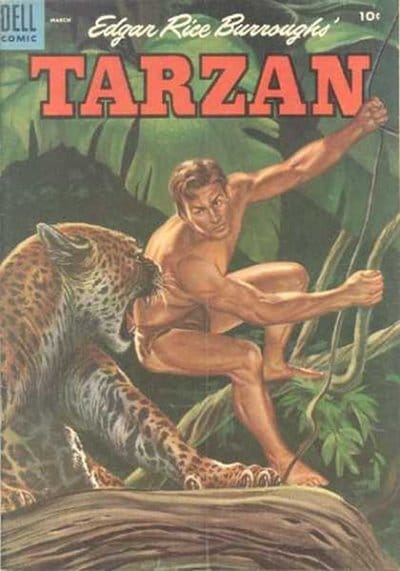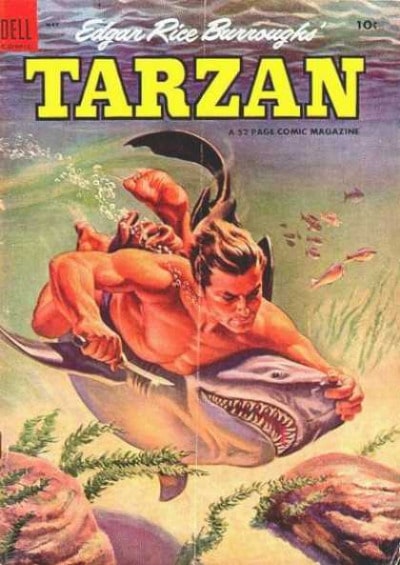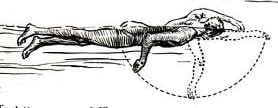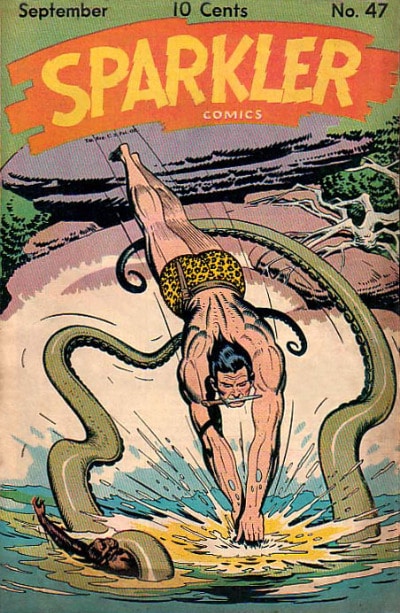
For nearly 100 years, Tarzan of the Apes has entertained and captivated men in print, radio, and film. To men who feel locked in an iron cage of corporate and suburban life, Tarzan represents the possibility of harnessing their primal side and escaping into the wild to revitalize their man spirit. In fact, Edgar Rice Burroughs created the Tarzan character as an act of liberation from his disappointing and boring life. In an interview, Burroughs acknowledged this motivation:
“We wish to escape not alone the narrow confines of city streets for the freedom of the wilderness, but the restrictions of man-made laws, and the inhibitions that society has placed upon us. We like to picture ourselves as roaming free, the lords of ourselves and of our world; in other words, we would each like to be Tarzan. At least I would; I admit it.”
Tarzan represents the idealized “noble savage.” The son of British nobility, he is adopted and raised by a tribe of apes when his parents are marooned and die on the coast of West Africa. Tarzan later meets an American woman, Jane, whom he takes as his wife, and the two attempt to make a normal life for themselves in England. But the chafing constraints and galling hypocrisies of civilized society drive Tarzan back to the jungle. Virtuous, heroic, and athletic, only the wilderness offered the freedom and adventure that felt like home.
When Burroughs introduced Tarzan in a pulp magazine in 1912, he created one of the first superheroes in America. Tarzan developed special talents and abilities that allowed him to survive and thrive in the jungle. He could climb trees and swing from branches in the jungle just as quickly and deftly as the apes who raised him. Unlike his monkey “family,” Tarzan was a skilled swimmer which turned him into an amphibious killer. He’d dive from staggering heights and swim great distances. In addition to his physical gifts, Tarzan developed several mental talents. He could learn new languages in days and could even speak with animals.
Boys and men at the turn of the 20th century wanted to emulate Tarzan the Ape Man. Tarzan’s physical prowess has inspired men for nearly 100 years to get in shape and harness their inner wild man. Today, we’re giving a short primer on developing four of Tarzan’s key skills: swimming, diving, climbing, and swinging. While you may never need to swing from a vine to save your lady or climb a tree to save your own life, it’s good to know you could if you had to!
How to Swim Like Tarzan

In Tarzan movies, a frequent scene is that of the Ape Man diving into a river and swimming briskly to fight an alligator that’s circling Jane. Tarzan engages in an underwater battle with the giant reptile and defeats it by snapping its neck or stabbing it with a knife. But to get to the alligator before it eats his lady, Tarzan has to swim fast.
In the movies, Tarzan always uses the front crawl stroke (what we often call the freestyle). And with good reason. The front crawl (aka the forward or American/Australian crawl) is the fastest and most efficient of all the swim strokes. Swimming is such an essential Tarzan skill that the movie producers back in the 1930s brought in Johnny Weissmuller, a five-time Olympic gold medalist in swimming, to play the role of Tarzan.
The technique for the Tarzan front crawl is pretty basic. Float face down in the water with both arms stretched out in front of you. This is the starting position. Flutter your legs alternately in short, up and down thrashes. The arms move in alternating sweeping strokes. The arm movement can be broken down into three parts: pull, push, and recovery.
Lower your hand into the water so that your thumb enters first. This is called “catching the water” and prepares you for the pull. The pull movement follows a semicircle pattern under the water. It ends at the front of the chest, as seen here:

The push begins when your hand reaches about where your ribcage is. You’ll feel your palm pushing the water behind you, instead of pulling it towards you. The push ends with your arm at the side of your body.
The recovery begins after the push. Bring your hand out of the water, bend your elbow, and circle your forearm outward until it points ahead. The arm glides out straight ahead to full reach in front.

While performing the front crawl keep your face in the water.
Breathing is done by twisting the head to one side, so that your face rises above the water surface. After taking in air, the face is submerged again and the swimmer exhales out his nose underwater. How often you breath depends on your personal preference. Some swimmers take in a breath every other arm stroke, while others will take in a breath every third arm stroke.
How to Dive Like Tarzan

Tarzan is constantly diving into rivers to save one of his monkey friends or his perennial damsel in distress, Jane. In Tarzan’s New York Adventure, he takes a death defying dive from the Brooklyn Bridge in order to escape the police, so he can save a jungle boy who was taken by the circus.
Diving headfirst into water allowed Tarzan to get to where he was going quickly. Plus it just looks cool to do a swan dive from a tree limb.
We’re not going to get too fancy here. Just a brief explanation on how to perform a simple headfirst dive is in order. Step back about three steps from the edge of the water. Take three quick steps and when you reach the edge of solid ground, plant your feet, bend your knees, and jump up and out towards the water. Place your hands straight above your head and extend your arms all the way. Your body should be stretched into a straight, rigid line when you enter the water in order to create a clean entry. Try to enter the water at about a 70-85-degree angle.
When you finally hit the water, don’t collapse your body. That’s a mistake a lot of beginners make. Carry your dive as far below the water as you can.
The higher up the position from which you dive from, the greater the danger. Jump from a 32-foot cliff, and you’ll hit the water at 35 mph; jump from a 70-foot cliff and you’ll hit at 46 mph. At that speed, the water will hardly cushion your fall, and you can obviously get seriously hurt. If you have to jump into the water from a great height, it’s recommend that you use the “pin dive.” It isn’t a dive in the headfirst sense; instead, you jump feet first, straight as a pin, arms at your side, feet pointed downward. Keep your body stiff and rigid and don’t let your body lean forward or backwards. The idea here is to minimize the points of contact between your body and the water when you hit the surface. You’ll notice that even professional cliff divers often start their dive headfirst, but then flip in the air so that they hit the water in the pin dive position.
How to Climb Like Tarzan

Because Tarzan was raised by apes, he developed climbing skills that no ordinary man could match. In a matter of seconds, Tarzan could scale a jungle tree to fight a jaguar or escape a herd of raging rhinos.
When most men climb, be it a tree or wall, they try to rely on their upper-body strength alone. The secret, however, to climbing any object successfully is in the legs. Your legs are not only stronger than your arms, but they’re also better able to bear your body weight. So use your arms and hands to steady yourself and let your legs be the engine of your effort.
Of course, climbing a tree with ample, low-hanging branches is one thing, climbing a tree sans branches quite another. When climbing a branchless tree, wrap your arms around the tree and place the soles of your feet on each side of the tree, with your legs bowed outward. Then walk or hop your feet upwards. These amazing great-grandchildren of Tarzan, who may or may not have been raised by apes themselves, will show you how it’s done:
How to Swing Like Tarzan

Perhaps Tarzan’s most iconic skill was his ability to traverse the jungle by swinging from vine to vine in the jungle canopy. But interestingly enough, Edgar Burroughs never described Tarzan performing this feat. Perhaps he understood what Hollywood did not: in real life, the vines that Tarzan uses to swing (lianas) are attached at the bottoms of trees, not the tops as in the movies. So swinging from vine to vine sadly isn’t possible in the real world.
Nonetheless, Tarzan did do his fair share of swinging. He would use the limbs and branches of trees like the parallel or uneven bars you see in gymnastics. Tarzan would swing his body back and forth to build momentum so he could hurtle his body through space and to the next limb. Just as primates living in the jungle get around the tree tops. And kind of like the guys in the above video.
I’ll be honest. I like the movie version of swinging Tarzan. As a boy, whenever I saw a rope hanging from some fixed object, I’d instinctively run towards it, leap into the air, grab hold of the rope, and swing as high as I could while giving my best Tarzan yell. I know I’m not the only kid who did this.
While you may never have to perform an uneven bars routine in a tree, you’ll probably have to bust out some rope swinging skills at some point in your life, even if it’s just at a team-building ropes course or at the old swimming hole.
If you’re a grown man, it may have been awhile since you swung like Tarzan. I know my rope swinging skills were bit rusty the last time I tried to swing from a rope and into a river. In my first attempt, I didn’t let go when I should have and ended up landing pretty close to a bunch of rocks near the shore. Not good. And kind of embarrassing.
A few pointers I took from my experience…First, make sure to grab the rope in the middle. Hold the rope tightly. Don’t wrap your legs around the rope as it creates a risk that you’ll get tangled up with the rope when you let go with your hands. The true trick to swinging from a rope is timing. I’ve found letting go right in the middle of the upwards trajectory to be the sweet spot. If you let go too early in the upwards arc, you’ll get distance in your drop, but you won’t get as much height. If you let go at the very top of the arc, your drop will have extra height but not as much distance. And of course, if you don’t let go at all, your swing will end up on YouTube and be watched by millions.
Bonus Skill: How to Yell Like Tarzan
 We couldn’t end a post about Tarzan skills without an explanation on how to perform the Lord of the Apes’ trademark yell.
We couldn’t end a post about Tarzan skills without an explanation on how to perform the Lord of the Apes’ trademark yell.
The Tarzan Yell was developed by actor Johnny Weissmuller during his stint as Tarzan. Lots of stories exist as to how the yell was created. One newspaper article claimed that, “Blended in with that voice are the growl of a dog, a trill sung by a soprano, a note played on a violin’s G string and the howl of a hyena recorded backward.” Another story posits that the yell is actually the voice of an Austrian yodel played backwards. However, Weissmuller stood firm in his claim that the yell was his own voice and was based on a yell he used as a child.
To perform the Tarzan Yell, just follow the official directions as written in Edgar Rice Burrough’s rejected trademark application for the Tarzan Yell:
The mark consists of the sound of the famous Tarzan yell. The mark is a yell consisting of a series of approximately ten sounds, alternating between the chest and falsetto registers of the voice, as follows –
- a semi-long sound in the chest register,
- a short sound up an interval of one octave plus a fifth from the preceding sound,
- a short sound down a Major 3rd from the preceding sound,
- a short sound up a Major 3rd from the preceding sound,
- a long sound down one octave plus a Major 3rd from the preceding sound,
- a short sound up one octave from the preceding sound,
- a short sound up a Major 3rd from the preceding sound,
- a short sound down a Major 3rd from the preceding sound,
- a short sound up a Major 3rd from the preceding sound,
- a long sound down an octave plus a fifth from the preceding sound.
Got that? Now go out and rule the jungle!


